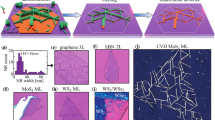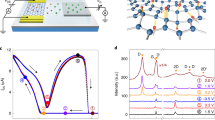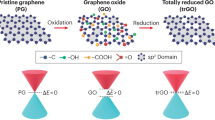Abstract
The integration of novel materials such as single-walled carbon nanotubes and nanowires into devices has been challenging, but developments in transfer printing and solution-based methods now allow these materials to be incorporated into large-area electronics1,2,3,4,5,6. Similar efforts are now being devoted to making the integration of graphene into devices technologically feasible7,8,9,10. Here, we report a solution-based method that allows uniform and controllable deposition of reduced graphene oxide thin films with thicknesses ranging from a single monolayer to several layers over large areas. The opto-electronic properties can thus be tuned over several orders of magnitude, making them potentially useful for flexible and transparent semiconductors or semi-metals. The thinnest films exhibit graphene-like ambipolar transistor characteristics, whereas thicker films behave as graphite-like semi-metals. Collectively, our deposition method could represent a route for translating the interesting fundamental properties of graphene into technologically viable devices.
This is a preview of subscription content, access via your institution
Access options
Subscribe to this journal
Receive 12 print issues and online access
$259.00 per year
only $21.58 per issue
Buy this article
- Purchase on Springer Link
- Instant access to full article PDF
Prices may be subject to local taxes which are calculated during checkout




Similar content being viewed by others
References
Ahn, J. H. et al. Heterogeneous three-dimensional electronics by use of printed semiconductor nanomaterials. Science 314, 1754–1757 (2006).
Wu, Z. C. et al. Transparent, conductive carbon nanotube films. Science 305, 1273–1276 (2004).
Snow, E. S., Perkins, F. K., Houser, E. J., Badescu, S. C. & Reinecke, T. L. Chemical detection with a single-walled carbon nanotube capacitor. Science 307, 1942–1945 (2005).
Artukovic, E., Kaempgen, M., Hecht, D. S., Roth, S. & Gruner, G. Transparent and flexible carbon nanotube transistors. Nano Lett. 5, 757–760 (2005).
Kang, S. J. et al. High-performance electronics using dense, perfectly aligned arrays of single-walled carbon nanotubes. Nature Nanotech. 2, 230–236 (2007).
Fan, Z. et al. Wafer-scale assembly of highly ordered semiconductor nanowire arrays by contact printing. Nano Lett. 8, 20–25 (2008).
Liang, X., Fu, Z. & Chou, S. Y. Graphene transistors fabricated via transfer-printing in device-active areas on large wafer. Nano Lett. 7, 3840–3844 (2007).
Chen, J. H. et al. Printed graphene circuits. Adv. Mater. 19, 3623–3627 (2007).
Meitl, M. A. et al. Transfer printing by kinetic control of adhesion to an elastomeric stamp. Nature Mater. 5, 33–38 (2006).
Li, D., Muller, M. B., Gilje, S., Kaner, R. B. & Wallace, G. G. Processable aqueous dispersions of graphene nanosheets. Nature Nanotech. 3, 101–105 (2008).
Novoselov, K. S. et al. Electric field effect in atomically thin carbon films. Science 306, 666–669 (2004).
Geim, A. K. & Novoselov, K. S. The rise of graphene. Nature Mater. 6, 183–191 (2007).
Schedin, F. et al. Detection of individual gas molecules adsorbed on graphene. Nature Mater. 6, 652–655 (2007).
Han, M. Y., Ozyilmaz, B., Zhang, Y. B. & Kim, P. Energy band-gap engineering of graphene nanoribbons. Phys. Rev. Lett. 98, 206805 (2007).
Barbolina, I.I . et al. Submicron sensors of local electric field with single-electron resolution at room temperature. Appl. Phys. Lett. 88, 013901 (2006).
Tombros, N., Jozsa, C., Popinciuc, M., Jonkman, H. T. & van Wees, B. J. Electronic spin transport and spin precession in single graphene layers at room temperature. Nature 448, 571–574 (2007).
Berger, C. et al. Ultrathin epitaxial graphite: 2D electron gas properties and a route toward graphene-based nanoelectronics. J. Phys. Chem. B 108, 19912–19916 (2004).
Coraux, J., N'Diaye, A. T., Busse, C. & Michely, T. Structural coherency of graphene on Ir(111). Nano Lett. 8, 565–570 (2008).
Stankovich, S. et al. Graphene-based composite materials. Nature 442, 282–286 (2006).
Gomez-Navarro, C. et al. Electronic transport properties of individual chemically reduced graphene oxide sheets. Nano Lett. 7, 3499–3503 (2007).
Gijie, S., Han, S., Wang, M., Wang, K. L. & Kaner, R. B. A chemical route to graphene for device applications. Nano Lett. 7, 3394–3398 (2007).
Wang, X., Zhi, L. & Mullen, K. Transparent, conductive graphene electrodes for dye-sensitized solar cells. Nano Lett. 8, 323–327 (2007).
Jung, I. et al. Simple approach for high-contrast optical imaging and characterization of graphene-based sheets. Nano Lett. 7, 3569–3575 (2007).
Schniepp, H. C. et al. Functionalized single graphene sheets derived from splitting graphite oxide. J. Phys. Chem. B 110, 8535–8539 (2006).
McAllister, M. J. et al. Single sheet functionalized graphene by oxidation and thermal expansion of graphite. Chem. Mater. 19, 4396–4404 (2007).
Stankovich, S. et al. Stable aqueous dispersions of graphitic nanoplatelets via the reduction of exfoliated graphite oxide in the presence of poly(sodium 4-styrenesulfonate). J. Mater. Chem. 16, 155–158 (2006).
Hirata, M., Gotou, T., Horiuchi, S., Fujiwara, M. & Ohba, M. Thin-film particles of graphite oxide 1: High-yield synthesis and flexibility of the particles. Carbon 42, 2929–2937 (2004).
Hu, L., Hecht, D. S. & Gruner, G. Percolation in transparent and conducting carbon nanotube networks. Nano Lett. 4, 2513–2517 (2004).
Unalan, H. E., Fanchini, G., Kanwal, A., Du Pasquier, A. & Chhowalla, M. Design criteria for transparent single-wall carbon nanotube thin-film transistors. Nano Lett. 6, 677–682 (2006).
Stankovich, S. et al. Synthesis of graphene-based nanosheets via chemical reduction of exfoliated graphite oxide. Carbon 45, 1558–1565 (2007).
Ferrari, A. C. et al. Raman spectrum of graphene and graphene layers. Phys. Rev. Lett. 97, 187401 (2006).
Watcharotone, S. et al. Graphene–silica composite thin films as transparent conductors. Nano Lett. 7, 1888–1892 (2007).
Uher, C. & Sander, L. M. Unusual temperature dependence of the resistivity of exfoliated graphites. Phys. Rev. B 27, 1326–1332 (1983).
Acknowledgements
The authors would like to acknowledge Yun-Yue Lin and S. Miller for fabricating organic photovoltaic devices. A detailed study on the photovoltaic devices will be reported elsewhere. We also acknowledge A. Kanwal for help with the low-temperature measurements, and thank O. Celik for help with XPS analysis and A. Mann for allowing us the use of the Raman instrument. This work was funded by the National Science Foundation CAREER Award (ECS 0543867).
Author information
Authors and Affiliations
Corresponding author
Supplementary information
Rights and permissions
About this article
Cite this article
Eda, G., Fanchini, G. & Chhowalla, M. Large-area ultrathin films of reduced graphene oxide as a transparent and flexible electronic material. Nature Nanotech 3, 270–274 (2008). https://doi.org/10.1038/nnano.2008.83
Received:
Accepted:
Published:
Issue Date:
DOI: https://doi.org/10.1038/nnano.2008.83
This article is cited by
-
Graphene oxide synthesis and applications in emerging contaminant removal: a comprehensive review
Environmental Sciences Europe (2024)
-
Transient chemical and structural changes in graphene oxide during ripening
Nature Communications (2024)
-
Progress and prospects of graphene-based materials in lithium batteries
Rare Metals (2024)
-
Recent synthetic strategies of small heterocyclic organic molecules with optoelectronic applications: a review
Molecular Diversity (2024)
-
Understanding the 2D-material and substrate interaction during epitaxial growth towards successful remote epitaxy: a review
Nano Convergence (2023)



